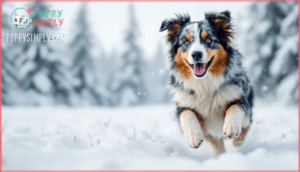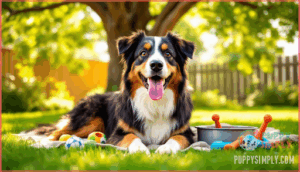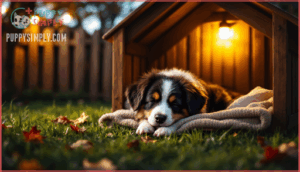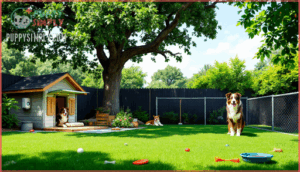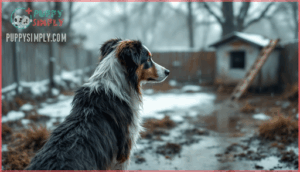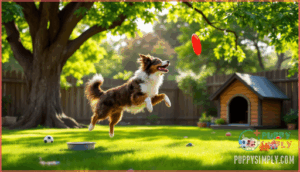This site is supported by our readers. We may earn a commission, at no cost to you, if you purchase through links.

But can Australian Shepherds tolerate being kept outside safely, or do their ranch roots hide some modern needs? Understanding how Aussies cope with cold, what shelter suits them, and how outdoor living affects their health helps you keep your dog happy and protected, no matter the season.
Table Of Contents
- Key Takeaways
- Were Aussies Bred as Outdoor Dogs?
- Do Aussies Like The Cold?
- Ensuring Proper Shelter
- An Aussie’s Comfort Outdoors
- What Age Can Aussies Sleep Outside?
- Providing Water Access Outside
- The Pros of Outdoor Living
- The Cons of Outdoor Living
- An Aussie’s Outdoor Needs
- Frequently Asked Questions (FAQs)
- What are some signs my Aussie is uncomfortable or unhappy living outdoors?
- What steps should I take to socialize my Aussie if it lives outdoors?
- How can I provide mental stimulation for my Aussie while it’s outside?
- How do Australian Shepherds handle outdoor pests?
- Can Australian Shepherds be left outside overnight?
- Is outdoor living suitable for senior Aussies?
- What outdoor activities do Aussies enjoy most?
- How does outdoor living affect Aussie socialization?
- Conclusion
Key Takeaways
- Australian Shepherds can live outside if they have sturdy, insulated shelter and constant access to fresh water.
- Their double coat gives decent protection, but extreme temperatures—hot or cold—can still put them at risk.
- Aussies need daily exercise, mental stimulation, and regular human interaction to stay happy and healthy outdoors.
- Puppies under six months and senior dogs are more sensitive to weather and should not sleep outside without extra care.
Were Aussies Bred as Outdoor Dogs?
Ever wonder why Australian Shepherds seem so at home outdoors? It’s all thanks to their Herding Heritage and Ranch Origins. The Australian Shepherd breed was shaped by generations of herding dogs, especially those from Basque and British collie lines. These ancestors spent long days working livestock across open ranches, building Outdoor Adaptability into the breed’s DNA.
Aussies have Working Instincts that make them enthusiastic to be outside, alert, and busy. Their double coat helps shield them from the elements, but it’s not a suit of armor. While Australian Shepherds thrive with outdoor activity, they weren’t bred to live outside all the time.
Modern Australian Shepherd temperament leans toward companionship. The breed’s origin can be traced to Basque herding dogs from Spain. Most Aussies prefer relaxing indoors with their people once the day’s work is done.
Do Aussies Like The Cold?
After a busy day herding or playing, Australian Shepherds often show a real spark for cold weather play. Their winter coat gives decent insulation, but it’s not as thick as some northern breeds. That means coat insulation factors only go so far—each Aussie’s individual cold tolerance can vary. Some will romp for hours in the snow, while others seek warmth sooner.
Watch for hypothermia risk signs, like shivering or slow movement, especially if their fur gets wet. Temperature tolerance in dogs isn’t one-size-fits-all. Most Aussies tolerate mild winter days well, but cold weather dog care means keeping an eye out when the thermometer drops.
Breeds’ cold limits matter, so don’t push your dog beyond what’s safe for their comfort. Despite their origins in warmer climates, Australian Shepherds have a decent cold tolerance.
Ensuring Proper Shelter
If your Aussie is spending time outside, making sure they have a sturdy, weatherproof shelter matters just as much as watching the thermometer on chilly days. Think of their dog house like a safe haven—a place that shields them from wind, rain, and heat.
The right kennel size should let them stand, turn, and stretch easily. Shelter material needs to be durable, like treated wood or thick plastic, to withstand rough weather. Insulation needs are important, too; foam boards and straw bedding help keep warmth in and moisture out.
Location matters, so place the shelter in a spot with shade and away from standing water. For extra weather protection, look for dog shelter options with door flaps and raised floors.
- Choose proper kennel size for comfort
- Pick weatherproof shelter material
- Insulate for year-round protection
An Aussie’s Comfort Outdoors
Once your dog has a safe shelter, keeping them comfortable outside means thinking about shade, space to play, and ways to keep their mind busy. Australian Shepherds thrive in outdoor living when you balance their need for activity with their weather sensitivity.
For instance, ideal temperatures for Aussies are between 68–74°F; anything hotter or colder can affect dog health. Their coat offers some protection, but isn’t foolproof against extremes. Breed adaptability helps, but outdoor happiness depends on more than just their fur.
Give them toys, training, and regular walks. Watch for signs of stress, like whining or chewing. Staying tuned in to your dog’s comfort helps you provide the best dog care, no matter the season.
What Age Can Aussies Sleep Outside?
When your puppy hits the six-month point, it’s finally ready to start sleeping outside with the right setup and care. By this age, most Aussies have developed enough temperature tolerance to manage moderate outdoor conditions, thanks to their double coat. Still, each puppy is unique—some may need more time for weather acclimation or training readiness.
Think about socialization needs too, since puppies thrive on interaction. You’ll want to ease into outdoor sleeping, especially if your dog is new to changing temperatures. Older dogs may adjust faster, but young ones need extra support.
Here’s what helps make the adjustment smoother:
- Gradual exposure to outdoor temperature changes
- Consistent training and positive reinforcement
- Safe, insulated shelter with bedding and toys
Providing Water Access Outside
Out in the yard, your Aussie will need plenty of fresh water to keep up with all that running and exploring. Choose a sturdy water source type, like a heavy ceramic or stainless steel bowl, to avoid spills. Place bowls in shaded spots for easy access, and check them often—especially on hot summer days.
In winter, freezing prevention matters; heated bowls or frequent refills keep water from turning to ice. Clean the bowls daily to maintain good bowl hygiene and stop bacteria from growing. Hydration monitoring is key—watch how much your dog drinks and refill as needed.
Multiple water bowl placements around the yard mean your Aussie won’t have to search far. Fresh water, smart placement, and regular checks make all the difference.
The Pros of Outdoor Living
If you’re thinking about keeping your Aussie outside, it’s important to know what benefits outdoor living can offer. The right setup can make a big difference in your dog’s comfort and happiness.
Let’s look at some options that help meet their needs.
Exercise and Space
Think of your backyard as a playground—your Australian Shepherd needs room to run, explore, and burn off that endless energy every single day. Aussies thrive on daily exercise and open space. Without enough activity, their mental health and actions can suffer.
For instance, a securely fenced yard lets your dog zoom around, play fetch, and practice natural herding instincts without worrying about escapes. Interactive games and regular walks keep their breed energy in check and fulfill their exercise needs. You’ll notice how outdoor activities like running and sniffing help prevent boredom and destructive habits.
If you’re wondering what a happy Aussie’s day looks like, picture:
- Chasing a ball across the yard
- Exploring new scents and sights
- Practicing agility with you by their side
That’s exercise and space at work.
Temperature Control
Ever notice how your Aussie seems ready for anything, rain or shine, thanks to their thick, weather-proof coat? That’s Coat Insulation at work. Still, Ideal Temperature matters.
Extreme weather conditions—hot or cold—call for Heatstroke Prevention and Hypothermia Risks awareness. Climate Adaptations help, but always monitor temperature regulation.
Outdoor dogs need safe shelter and water, especially in hot weather.
The Cons of Outdoor Living
Keeping your Aussie outside comes with a few important drawbacks to think about. Some challenges can affect their health and happiness if you’re not prepared.
Let’s look at what you need to remember for a safe outdoor setup.
Mental Stimulation
Imagine spending all day in the backyard with nothing to do—it’s no wonder Australian Shepherds get bored fast without something to challenge their minds. These dogs thrive on mental stimulation, not just physical exercise. If you don’t provide puzzle toys, training games, or regular social interaction, boredom sets in quickly. That leads to unwanted dog actions like digging, chewing, or barking.
Australian Shepherds quickly become bored and destructive outdoors if their minds aren’t kept busy with games, toys, or interaction
For effective boredom prevention, rotate cognitive enrichment activities, practice dog training and socialization, and set up scent games outside. Your Aussie needs daily challenges to stay sharp and content.
Extreme Temperatures
Ever wondered how quickly an Aussie can go from happy to uncomfortable in extreme weather conditions? Their double coat helps, but it’s not magic. You need to watch for:
- Heatstroke symptoms during hot spells—shade and water are musts for summer safety.
- Hypothermia risks when cold weather bites, especially below freezing.
- Sudden temperature swings from climate change that test their temperature tolerance in dogs.
Don’t risk your dog’s health outdoors.
An Aussie’s Outdoor Needs
Now that you know the challenges, let’s talk about what your Aussie needs to stay happy and healthy outside. Australian Shepherds thrive with outdoor activities, but they need safe fencing requirements to keep them secure.
Their breed temperament means they crave companionship, so outdoor socialization is essential—don’t let them feel isolated. Regular supervision is key; check on them often, especially during weather changes.
Provide a sturdy dog shelter with insulation and bedding for protection. Keep fresh water available at all times. Activity levels matter too—engage them with interactive play and mental stimulation, like puzzle toys, to keep their minds busy.
With attentive outdoor dog care, your Australian Shepherd can enjoy outdoor living safely.
Frequently Asked Questions (FAQs)
What are some signs my Aussie is uncomfortable or unhappy living outdoors?
If your Australian Shepherd shows excessive barking, destructive actions, appetite changes, sleep disturbances, or social withdrawal, these are signs of discomfort.
Watch for health issues, as dog actions often reflect problems with comfort and wellbeing outdoors.
What steps should I take to socialize my Aussie if it lives outdoors?
Coincidentally, frequent exposure is key—bring your Aussie inside often for supervised playdates and human interaction.
Outdoor socialization tips include off-leash walks, meeting other dogs, and joining training classes to tackle socialization challenges and encourage healthy dog conduct.
How can I provide mental stimulation for my Aussie while it’s outside?
You can use Puzzle Toys, Scent Work, and Interactive Games to keep your Australian Shepherd’s mind active outdoors.
Try Outdoor Training, foraging activities, and rotating toys. These options offer mental stimulation and support healthy dog exercise and play.
How do Australian Shepherds handle outdoor pests?
Ticks, fleas, and mosquitoes can cause dog health issues for Australian Shepherds outdoors.
Regular dog grooming and shedding checks, insect repellents, and tick prevention help lower pest-borne diseases. Flea control also aids Australian Shepherd health and safety.
Can Australian Shepherds be left outside overnight?
Overnight safety starts with sturdy shelter and constant care. Weather risks and social isolation can stress Australian Shepherds. If you let yours live outside, check breed temperament and owner responsibilities.
Dog winter care and protection matter most.
Is outdoor living suitable for senior Aussies?
Outdoor living for senior Aussies isn’t ideal. Joint pain risks, cognitive decline, and limited mobility make weather sensitivity a real concern.
Senior Aussie health depends on comfort, temperature tolerance, and close monitoring for dog health and wellbeing.
What outdoor activities do Aussies enjoy most?
Ready to offer some fun? Herding Instincts shine during dog park play, while Agility Training and Frisbee Fun keep Australian Shepherds moving.
Hiking Adventures and Swimming Safety offer exercise times that challenge both mind and body with every outdoor activity.
How does outdoor living affect Aussie socialization?
Without enough human interaction, outdoor isolation can lead to social deprivation and negative behavioral impacts.
Australian Shepherds need pack dynamics and regular dog socialization to thrive, so limiting contact may affect dog demeanor and socialization needs.
Conclusion
Australian Shepherds are tough yet sensitive—a paradox that shapes their outdoor lives. You might think their thick coats mean they can withstand anything, but comfort depends on more than fur.
If you’re wondering, can Australian Shepherds be kept outside, the answer is yes—with care. Shelter, water, and attention matter as much as space. When you balance their ranch spirit with their need for safety, your Aussie thrives.
It’s not just about where they live, but how they’re loved.
- https://www.sniffspot.com/blog/dog-breeds/explore-the-australian-shepherd-genuine-tips-from-9000-owners
- https://www.petscare.com/news/post/australian-shepherds-snow-guide
- https://iheartdogs.com/are-australian-shepherds-safe-in-cold-weather/
- https://jiminys.com/blogs/understanding-dogs/australian-shepherd-allergies
- https://www.woofz.com/blog/australian-shepherd-training/

